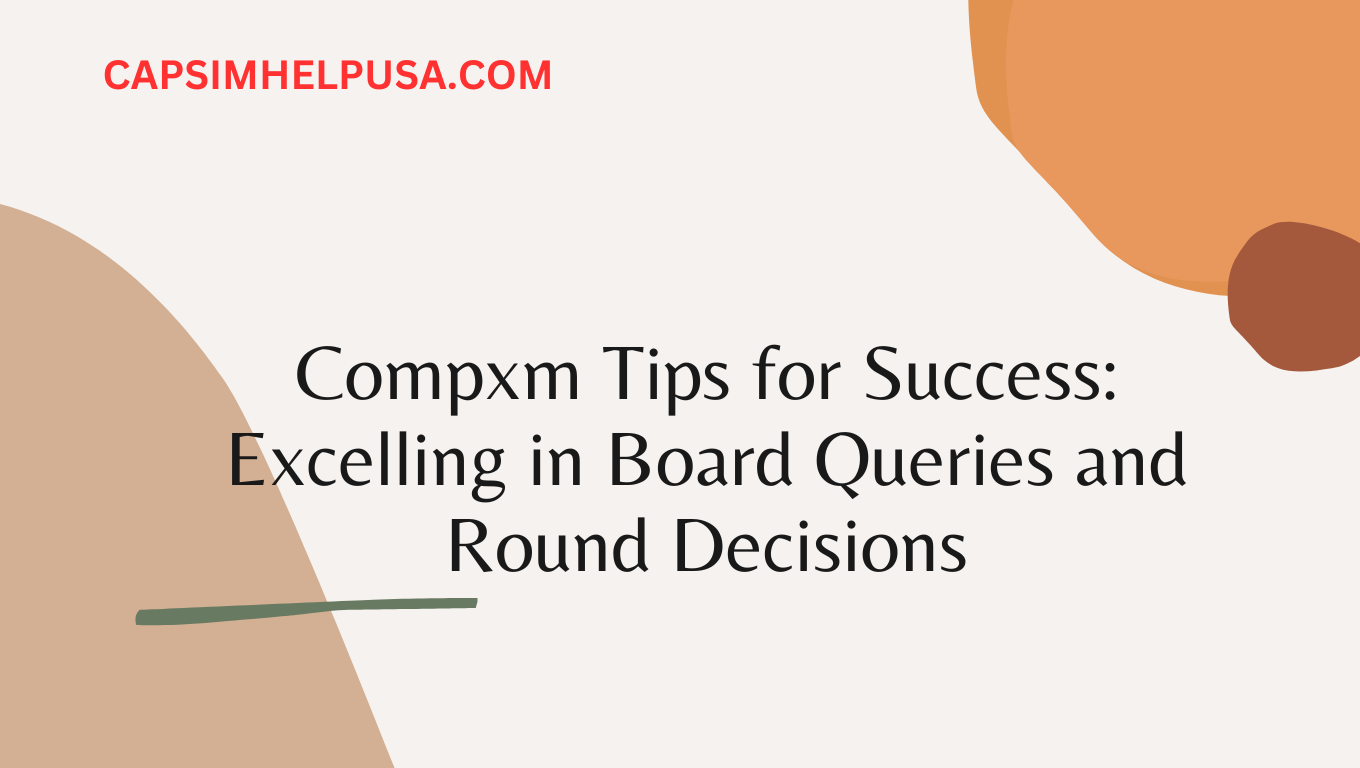Compxm Tips for Success: Excelling in Board Queries and Round Decisions

Introduction
The Capsim simulation includes the CompXM exam, which tests strategic thinking, analysis, and decision-making. Participants must understand facts and make informed decisions in its board queries and round decisions format. Round choices require a thorough approach to virtual firm management, while board queries challenge your analytical and interpretive skills with report-based questions. Success requires a balance of knowledge, strategy, and execution. Let's discuss how to thrive in both areas for great results.
Mastering Board Queries
Board queries test your ability to analyze specific business performance reports. Profitability, market share, and customer happiness are common indicators. This area requires deliberate approach to succeed.
Study the simulation reports first. Annual Reports, Market Segment Analysis, and Production Reports. The insights from these materials are essential for answering questions. For instance, the Annual Report shows financial performance, whereas the Market Segment Analysis shows customer preferences and rival activity. Knowing these resources helps you spot trends and develop.
Board questions generally focus on net profit margin, contribution margin, and market share. Interpreting these numbers is critical. A diminishing market share may suggest that a product no longer meets client needs. A low contribution margin may indicate manufacturing or price inefficiencies. Success depends on your ability to turn numbers into actionable insights.
Critical thinking is another board question need. You must identify a problem, comprehend its causes, and provide solutions. When customer satisfaction is low, product positioning, age, and MTBF should be examined to see what needs improvement. This analytical depth ensures precise and effective solutions.
Time management matters too. Board queries are timed, so use your time wisely. Avoid spending too much time on one question, which can leave you rushing to finish others. Practicing comparable questions before the exam helps boost speed and confidence. Making brief notes while reviewing data can also reduce report back-and-forth.
Making Winning Round Choices
CompXM's round decisions replicate corporate management difficulties. You make decisions for R&D, marketing, production, and finance. Successfully navigating this part demands strategic planning and flexibility.
Understanding client preferences is key to good decisions. Every simulation market niche has unique needs. High-tech customers value performance and size, while low-tech customers favor affordability and reliability. Market share is gained by tailoring items to these preferences.
Matching your choices with a company strategy is crucial. Determine your focus: cost leadership, differentiation, or specialized market before making any judgments. This plan should govern all departmental actions. If you want to differentiate through innovation, invest substantially in R&D and marketing to produce cutting-edge products and brand awareness.
R&D is crucial to product relevance. Product parameters are updated often to match client demands. Innovation must be balanced with practicality. High-tech clients want frequent updates, whereas low-tech customers want consistency and affordability. Strategic update timing ensures clients have new versions when they need them.
Marketing is also important. Budgeting for promotion and sales can increase client awareness and accessibility. Avoid overpaying because declining returns reduce profitability. Marketing effectiveness monitoring lets you allocate resources more efficiently.
Supply and demand must be balanced in production management. Underproduction risks stockouts and missed sales, while overproduction increases inventory costs. Automation can reduce labor costs, but too much can slow market adaptation.
Financial management links these factors. Sustaining operations and capturing opportunities requires robust cash flow. Overleveraging through debt or stock issue can hurt your company's finances and stock price. Analyzing proforma financial statements regularly lets you see problems and make corrections.
Another technique is competitor monitoring. Competitor data might highlight strengths and shortcomings, allowing you to alter your strategy. You might increase your low-tech position if a competitor dominates high-tech.
Finally, short-term and long-term goals must be balanced. Neglecting long-term goals might limit sustained growth, despite the temptation to focus on profit and market share. Investing in brand development and operational efficiency keeps your company competitive.
Board Queries and Round Decisions Integration
Board queries should inform round decisions, establishing a performance-boosting feedback loop. If a board query shows that your product is losing market share due to an old design, R&D should upgrade immediately. For poor customer awareness, boosting your marketing spend in the next cycle can help.
Board questions are opportunities to enhance your strategy, ensuring data-driven decisions that support your company's goals. This integrated strategy boosts exam performance and teaches real-world company management.
Common Mistakes to Avoid
Mistakes can hurt your performance despite your best efforts. Not following market trends is a common mistake. Missing opportunities can stem from failing to adapt your approach to changing customer preferences or competitive dynamics. Making decisions too complicated is another problem. Instead than trying too many things, focus on implementing a defined strategy.
Avoiding financial health is another mistake. Spending too much on one area can hurt cash flow and profitability. Finally, postponing board inquiries can result in hasty, erroneous responses. A disciplined timeframe for answering these questions helps you manage your task.
Practice Power
CompXM requires practice like any talent. Reviewing simulations, practicing board queries, and trying new techniques boost confidence. Knowing the exam format and prerequisites helps you perform well under pressure.
Conclusion
The CompXM exam is a challenging business and decision-making test. You can succeed by answering board questions well and making clever round decisions. For that purpose, you can ping us to take Compxm help at any time. The key is planning, analysis, and execution. You can handle test challenges by studying reports, understanding consumer needs, and making strategic judgments. CompXM success is possible with consistent practice and discipline.
Follow these tips to master CompXM.





